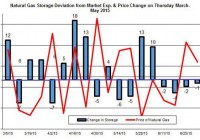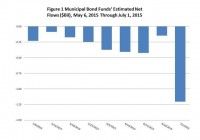UNG Remains Range-Bound
Summary The injection to storage was 69 Bcf – close to market expectations. The price of UNG bounced back. The demand for natural gas in the power sector could climb back up on account of warmer weather. The oil and natural gas market remained range-bound in recent weeks. The price of United States Natural Gas (NYSEARCA: UNG ) bounced back last week, even though the injection to storage was close to market expectations and the weather — while it keeps heating up in many parts in the U.S. — hasn’t driven up the demand for natural gas in the power sector. Moreover, the price of UNG remained range-bound for recent weeks. Will the warmer weather start to heart up the natural gas market? According to the latest EIA report , the injection to storage was 69 Bcf, which wasn’t far off market estimates. Over the next few weeks the market estimates the injections to storage will be higher than normal — on average over 85 Bcf per week, while the five-year average is around 65 Bcf. The higher injection could be driven by higher production and even more so by softer demand. But is the demand expected to cool down? As of last week, the natural gas market has cooled down. The demand for natural gas changed course and slipped by 3.2% week over week. Most of this fall came from softer demand in the power sector. Even though other sectors — including industrial and residential/commercial — also saw a decline in consumption. As of last week, total consumption is up by 4.6% year on year. That’s not far off of the current annual outlook growth in consumption. Despite the drop in demand for natural gas in the power sector, in the coming weeks the weather is projected to be much warmer than normal — mainly in the West and parts of the South Atlantic. Also, the cooling degree days (CDD) are estimated to be higher than normal by 9 degrees, and by 8 degrees compared to last year. The higher temperatures and CDD could suggest a rise in consumption in the power sector. How Will the Price of UNG React to the Storage Report? During the winter time, the price of natural gas tends to react to the news about the changes in storage. But during the summer the correlation tends to be weaker and has a smaller impact on the price of UNG. So far this injection season the price of natural gas seems partly correlated to the deviation from market expectations. (click to enlarge) Source: Data taken from the EIA. The natural gas output inched down by 0.2% last week, but it’s still up for the year by nearly 5%. Baker Hughes reported a decline of nine gas rigs to 219. Conversely, oil rigs have gone up by 12 during the previous week. But oil rigs are also down for the year. Finally, the movement in the oil market, which shouldn’t have an impact on natural gas prices, still seems to coincide to a certain extent, as presented in the chart below. The correlation between the two data sets is 0.24. (click to enlarge) Source: Data taken from the EIA. In both cases, energy prices have been range-bound as the market continues to figure out what’s next for the energy market, and if and when we will see a drop in the production of U.S. oil companies. So far, oil and gas companies have reduced the number operating rigs and slashed capex for 2015. But these measures have yet to cool down the U.S. oil and gas yield. The injection season still has a few more months to go, in which the injections to storage are still expected to be higher than normal. Nonetheless, the hotter-than-normal weather in the coming weeks could start again driving up the demand for natural gas in the power sector, which could bring the price of UNG back up. Or, at the very least, it could keep prices range-bound. (For more, please see ” Natural Gas Is Still Floating … Barely .”) Disclosure: I/we have no positions in any stocks mentioned, and no plans to initiate any positions within the next 72 hours. (More…) I wrote this article myself, and it expresses my own opinions. I am not receiving compensation for it (other than from Seeking Alpha). I have no business relationship with any company whose stock is mentioned in this article.

